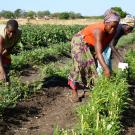This presentation, shared at the Horticulture Innovation Lab's 2018 annual meeting, details research that Jim Simon of Rutgers, the State University of New Jersey, and his team are endeavoring to see how African indigenous vegetables can combat hidden hunger and income inequality in western Kenya and eastern and central Zambia. These findings, if implemented on a broader scale, highlight key interventions that could help alleviate poverty among Kenyan and Zambian farmers and also improve access to nutrition in the region.
Highlights
- 90 percent of households in rural areas and those on the outskirts of urban areas view African indigenous vegetables as desirable food options, but survey respondents said that they rarely ate the vegetables because they are not readily available. This translates to a potential untapped market demand of millions of dollars and a major economic opportunity for growers as well as for consumers to have access to the nutritionally dense African indigenous vegetables.
- Households in rural areas are far more interested in African indigenous vegetables when they see them as a lucrative source of income. But, many producers lack access to African indigenous vegetables seeds, plant materials, fertilizer and pesticides, They also lack the credit to purchase these materials.
- Many Kenyans and Zambians are not aware of the nutritional benefits of African indigenous vegetables. Parents, grandparents and school teachers become far more excited about African indigenous vegetables when they understand their nutritional content.
- African indigenous vegetables are a source of pride and tradition for many, but because they are often foraged and not cultivated, they are undervalued.
- Simon's team identified slow bolt spider plant varieties that remain vegetative and could potentially offer multiple harvests per planting cycle.
- The Amanranth population that the team studied through field trials in New Jersey and Tanzania met or exceeded high source thresholds for calcium and magnesium. But the population did not always meet high source thresholds for iron. The group is working on amaranth lines with higher iron levels.
- The project team taught youth at the Tumaini Center for Street Boys in Kenya how to cultivate African indigenous vegetables in sacks, using a sustainable and economical urban agriculture technique, as well as how to market them. Engaging youth provides a new avenue to reach the next generation of farmers.

